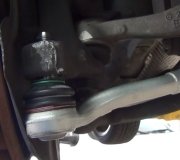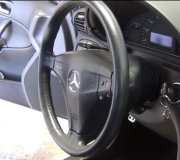GM had a real common problem with hard steering to one direction only, but that was solved many years ago. It was due to internal leakage inside the rack and pinion steering gear. That was a power steering issue.
There are a few different things that can cause hard steering just one way, but given the recent service, logic would dictate something was done inadvertently to cause it. Most notably would be over-tightening the new inner tie rod end, or it could have been on so tight that loosening it led to the problem. In either case, that could result in bending the rack. We talk about that all the time when discussing the procedure, but I've never actually seen that happen since the bars of steel are really beefy. To check for this, jack the front of the car up and support it with jack stands under the lower control arms. That will get the weight off the tires but keep the suspension in its normal geometry. Now turn the steering wheel from side to side to see if you notice a difference in effort. Don't get carried away because doing this too much will push power steering fluid out of the reservoir and make a mess.
If you feel a significant difference in steering effort, disconnect the outer tie rod ends from the spindles so each wheel can be turned independently. Feel if both wheels can be turned easily by hand. We use a fish scale to measure the force needed on larger trucks because it can be hard to estimate the force needed. With the tie rod ends still disconnected, turn the steering gear by the steering wheel again. If you still encounter more resistance one way, it has to be in the rack and pinion assembly because everything else is out of the picture.
If turning force is even both ways, try it again with the engine running. If you only encounter higher force with the engine running, it's a power assist problem. There's nothing a mechanic can do to cause that. It's caused by wear in the housing resulting in the pressurized fluid bypassing the power piston instead of pushing on it to help turn the steering linkage. That's what gave GM so much trouble in the mid to late '80s, but it always showed up before 50,000 miles. Their fix consisted of installing a new spool valve with new teflon sealing rings but the real cause was those rings wore grooves into the soft aluminum housing. The fix was only intended to be the cheapest way to get the cars out of the 50,000 mile warranty. After that, when the problem occurred again very soon, it was up to the owners to pay for the proper repair. That was to install an aftermarket rebuilt steering gear with a stainless steel liner that wouldn't develop those grooves.
The symptom was called "morning sickness" because it always affected the power assist in only one direction first thing in the morning. After the power steering fluid warmed up in as little as a few seconds to a couple of minutes, the power assist came back, usually for the rest of the day. Steering in the other direction was affected too within a few weeks.
If this is what you find, the steering gear will have to be replaced. As an additional clue, along with being hard to turn from centered to the right, it will be equally hard to turn from full-left back to centered. It's the direction that is the issue, not the position.
If you find the steering is hard only when you near a full-right turn, look at the accordion boot on the right inner tie rod to see if it's twisted. After a lock nut is loosened, it's the inner tie rod that is rotated to set "toe" for each wheel, which is the final pair of adjustments. Sometimes that boot sticks to the tie rod end and won't let it rotate freely. That will usually correct itself over time, but if it's too bunched up, it could impede free movement and not allow that tie rod to travel into the steering gear housing.
Checking for free movement of each wheel with the steering linkages disconnected is not practical unless the car is sitting on the turntables on the alignment hoist. You need the vehicle's weight on the struts to check for a binding upper strut mount. Most of the time a binding mount will cause a popping or thumping noise as you turn the steering wheel, and it will be worst when the car is not moving. There's an easy test for that.
An upper strut mount can simply be tight too but that isn't real common. It will typically be tight regardless of steering system position and usually causes hard steering both ways. In the rare event one just has a small tight spot, you should feel that tightness regardless of which way you're moving the steering wheel.
If none of these suggestions help, post the "after" readings for "caster" and "camber" from the alignment printout.
Tuesday, December 2nd, 2014 AT 10:42 PM



